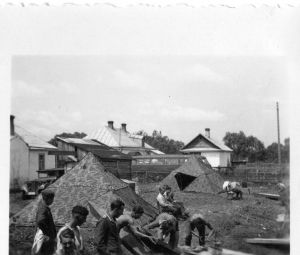Hermann Graebe
Eyewitness of Massacre at Dubno Airfield 5 October 1942

Dubno - During the Occupation
On 5 October 1942, Hermann Graebe a German engineer for the firm Jung A.G witnessed at the disused Dubno Airfield, an execution by an Einsatzgruppen unit which he recalled in an affidavit which was read by Sir Hartley Shawcross on 27 July 1946, at the International Military Tribunal in Nuremberg :
On 5 October 1942, when I visited the building office at Dubno, my foreman told me that in the vicinity of the site Jews from Dubno had been shot in three large pits, each about thirty metres long and three metres deep. About fifteen hundred persons had been killed daily. All were to be liquidated. As the shootings had taken place in his presence he was still very upset. Moennikes and I went straight to the pits. Nobody prevented us. I heard a quick succession of shots from behind one of the mounds of earth. The people who had got off the lorries – men, women and children of all ages – had to undress upon the order of an SS man, who carried a riding or dog whip. They had to put their clothes on separate piles of shoes, top clothing and underclothing. I saw a heap of shoes that must have contained eight hundred to one thousand pairs, great piles of clothes and undergarments.
Without screaming or weeping these people undressed, stood in family groups, kissed each other, said their farewells, and waited for a sign from another SS man, who stood near the pit, also with a whip in his hand. During the fifteen minutes that I stood near the pit, I did not hear anyone complain or beg for mercy. I watched a family of about eight, a man and a woman, both about fifty, with their children, aged about one, eight and ten, and two grown up daughters of about twenty to twenty-
I then walked round the mound and found myself confronted by a tremendous grave. People were closely wedged together and lying on top of each other so that only their heads were visible. Nearly all had blood running over their shoulders from their heads. Some of the shot people were still moving. Some lifted their arms and turned their heads to show that they were still alive. The pit was already three quarters full. I estimated that it held a thousand people. I looked for the man who did the shooting. He was an SS man who sat at the edge of the narrow end of the pit, his feet dangling into it. He had an automatic pistol on his knees and was smoking a cigarette. The people – they were completely naked – went down some steps which were cut in the clay wall of the pit and clambered over the heads of those who were lying there to the place to which the SS had directed them. They lay down in front of the dead and wounded. Some caressed the living and spoke to them in a low voice. Then I heard a series of shots. I looked into the pit and saw that their bodies still twitched or that their heads lay motionless on top of the other bodies before them: Blood ran from their necks.
I was surprised that I was not ordered off, but I saw that there were two or three postmen in uniform nearby. Already the next batch was approaching. They went down in the pit, lined themselves up against the previous victims and were shot. When I walked back round the mound, I noticed that another truckload of people had arrived. This time it included sick and feeble people. An old, terribly thin woman was undressed by others, who were already naked, while two people held her up. The woman appeared to be paralysed. The naked people carried her round the mound. I left with my foreman and drove in my car back to Dubno.
On the morning of the next day, when I visited the site, I saw about thirty naked people lying near the pit-
Sources:
M.Gilbert, The Holocaust – The Jewish Tragedy, published by Collins London 1986
G. Reitlinger, The Final Solution, Vallentine Mitchell, London 1953
Photograph - Tall Trees Archive, UK
© Holocaust Historical Society 2016

